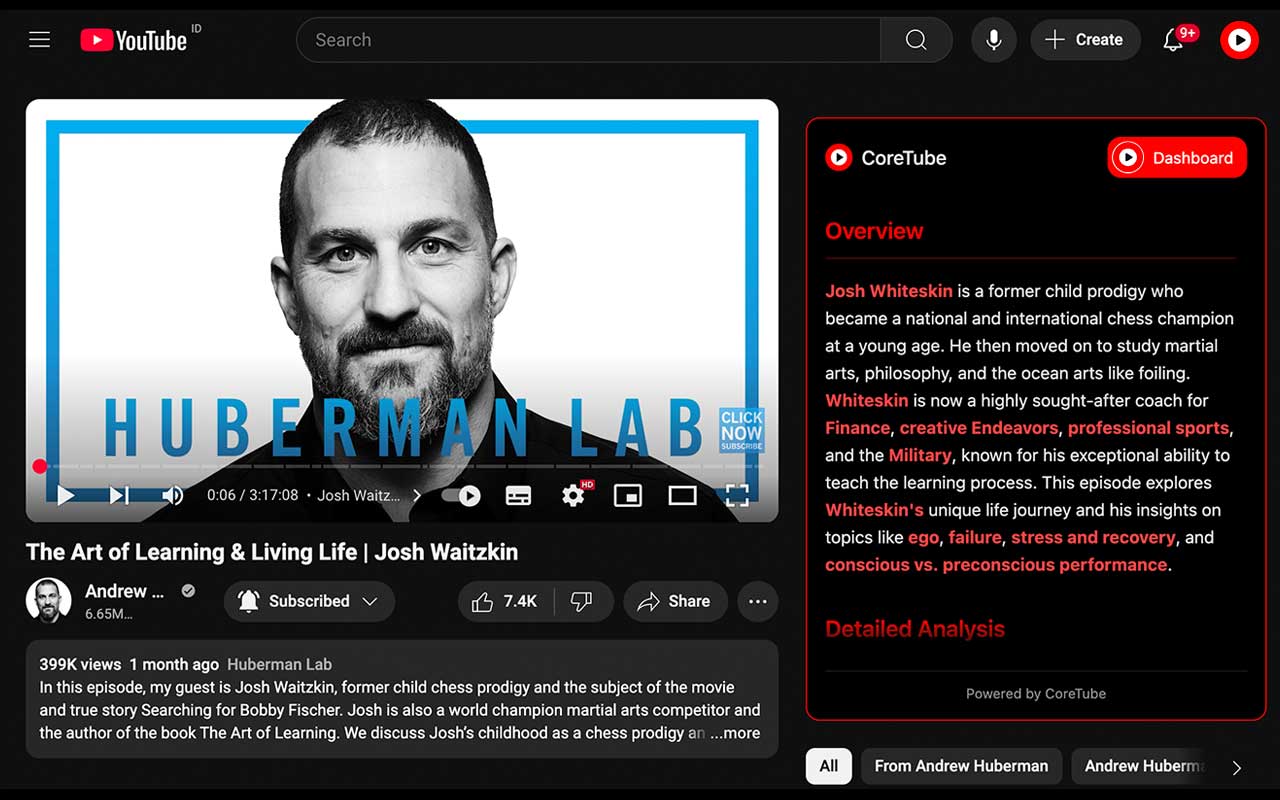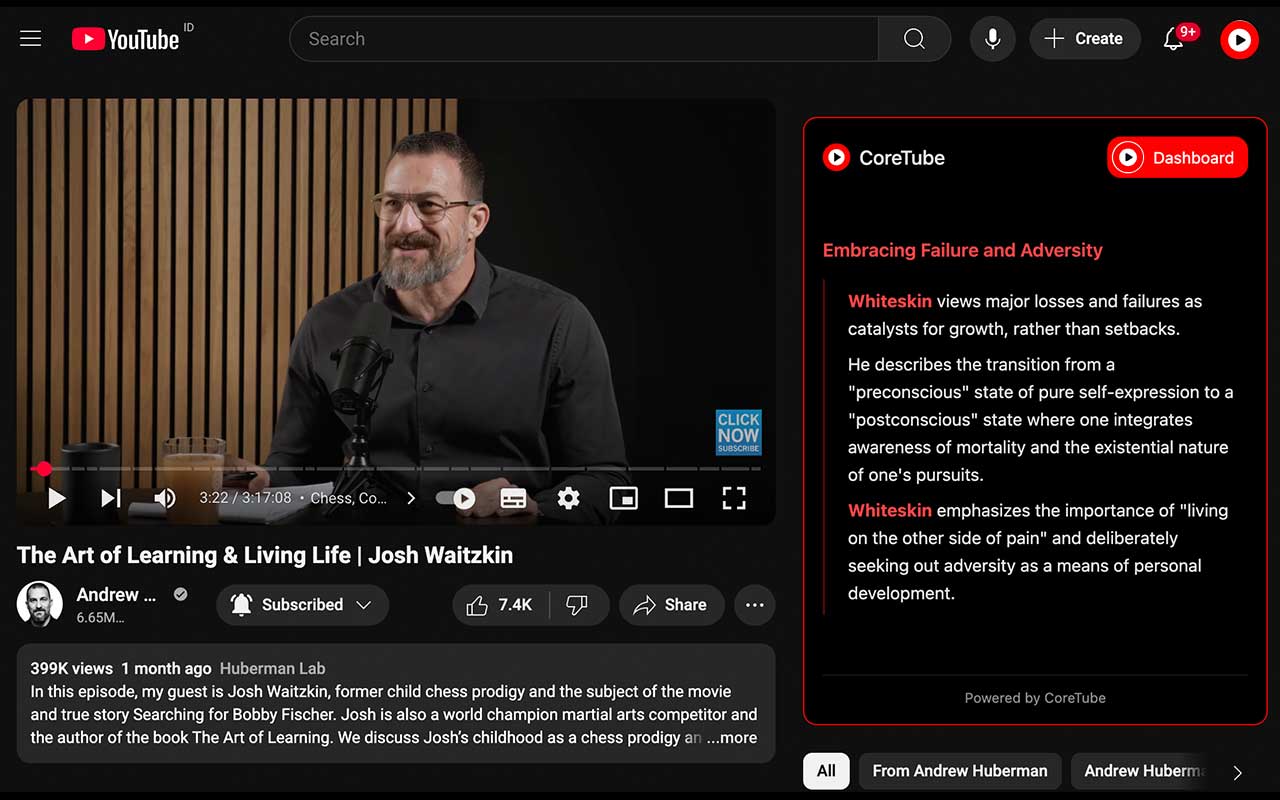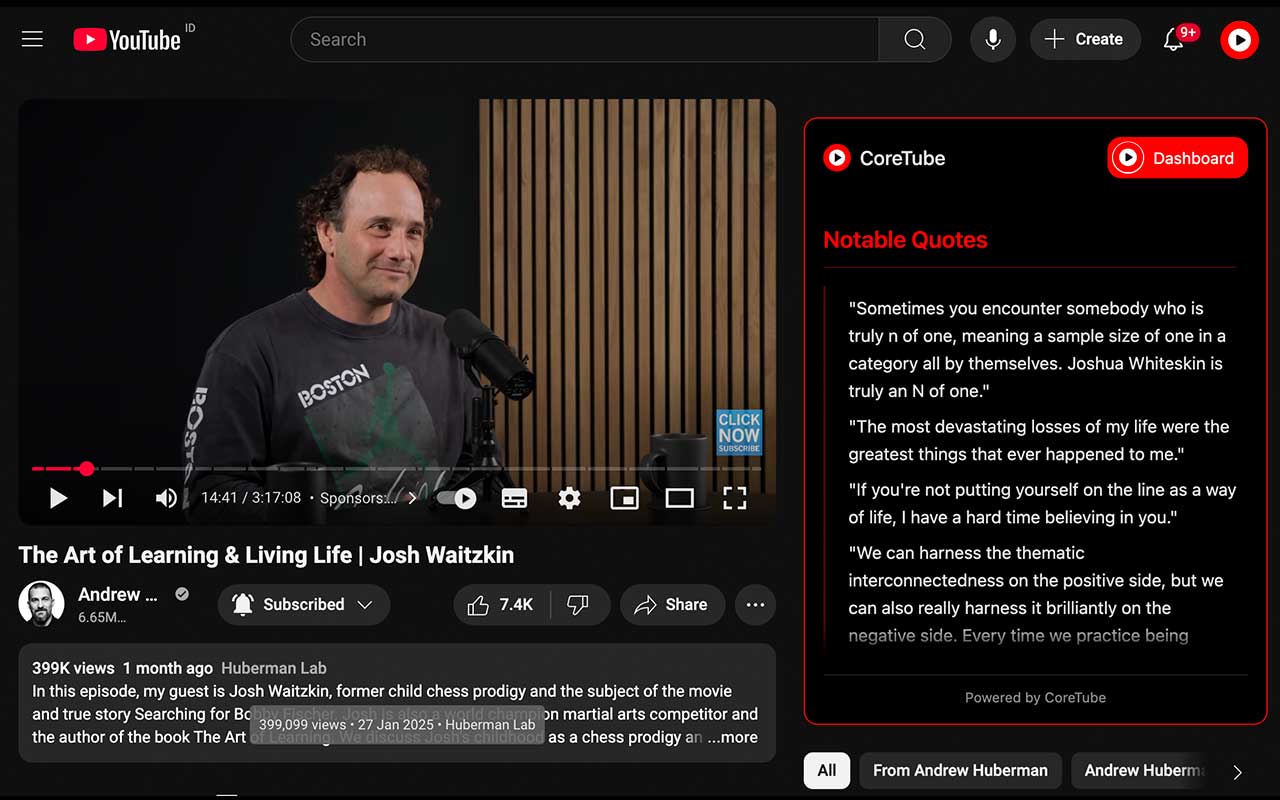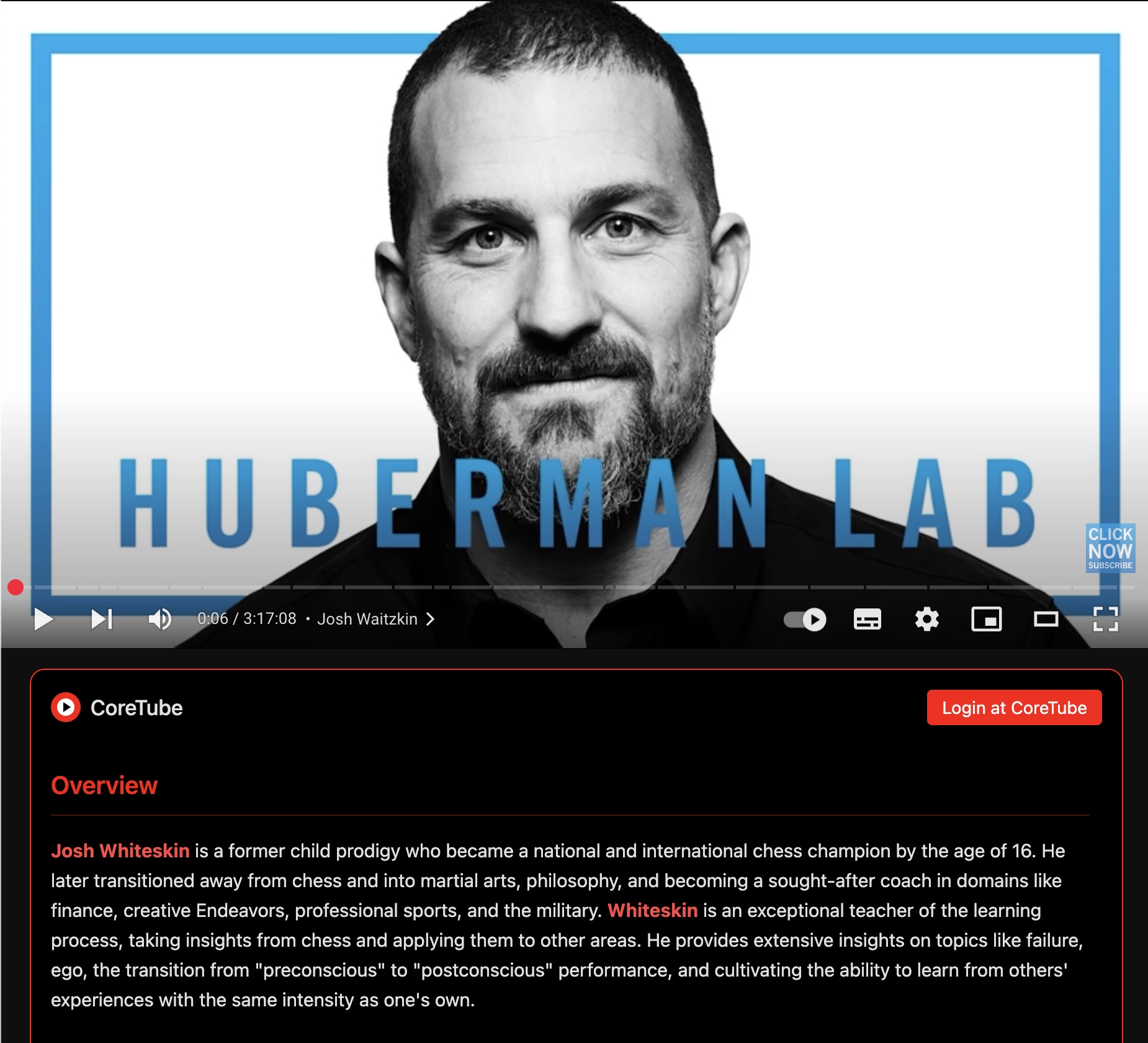YouTube Summarizer of your
Favourite Channels with AI
You Choose the Channels
We Deliver the Insights
Straight to Your Inbox
Get concise, actionable insights delivered instantly each time a new video drops.
Save time, learn faster, and never miss key insights with CoreTube.
Plus, summarize any video instantly with our Chrome extension.
Small Businesses CANNOT Afford to Make This Mistake
Alex Hormozi
January 10, 2025
Alex Hormozi - Podcast Video Summary
Overview
Keyman risk, single channel risk, and key customer risk are three major mistakes that prevent small businesses under $10 million from becoming big businesses. The video provides a detailed, actionable framework to identify and solve these issues, including building redundancy, diversifying customer acquisition channels, and aligning incentives with key vendors. Implementing these strategies can help stabilize the business, increase profitability, and make it more sellable.
Detailed Analysis
Keyman Risk
- Keyman risk occurs when a single person is vital to the operations of the business, and if they were to leave, the business would decrease materially in revenue or disappear.
- To solve keyman risk, the video recommends:
- Documenting processes and training others to replicate the key person's skills and responsibilities.
- Incentivizing the key person to stay, such as through equity vesting or other financial incentives.
- Keyman risk is a double-edged sword - the more valuable the key person becomes, the more critical it is to transfer their skills to others.
- Reducing keyman risk makes the business more sellable, as acquirers are less concerned about the business being dependent on a single person.
Single Channel Risk
- Single channel risk occurs when more than half of a business's customers or leads come from a single source, such as Facebook ads, organic content, or a single sales channel.
- If that primary channel were to stop working, it would materially affect the business's revenue.
- To solve single channel risk, the video recommends:
- Building long-term nurture channels like email marketing and referrals to diversify lead sources.
- Systematically adding new customer acquisition channels, one at a time, to reduce reliance on a single source.
- Avoiding the temptation to add both a new channel and a new person, as it's difficult to determine the root cause of success or failure.
Key Customer Risk
- Key customer risk occurs when a single customer or associated customers account for 20% or more of a business's revenue.
- Losing that key customer would have a material impact on the business's profitability and viability.
- To solve key customer risk, the video recommends:
- Actively acquiring more customers to reduce the percentage of revenue from the key customer.
- Negotiating long-term contracts with the key customer to lock them in.
- Acquiring more "whale" customers to diversify the customer base.
- In some cases, declining the key customer opportunity if it would fundamentally change the business's operations and customer focus.
Key Vendor Risk
- Key vendor risk occurs when a single vendor is responsible for a key function of the business, such as manufacturing, payment processing, or software development.
- If that vendor were to stop providing the service, it could cripple the business.
- To solve key vendor risk, the video recommends:
- Maintaining redundancy and backup options for critical vendors.
- Negotiating terms and covenants that protect the business, such as lead times, breakup fees, and service level agreements.
- Considering strategic acquisitions or "acqui-hires" of key vendors to permanently align incentives.
Statistics
No specific data points were presented in the video.
Notable Quotes
"The more valuable you become, the more of a key man you are, and the most valuable thing you can do next is learn how to transfer that skill to another person."
"The easy litmus test for good delegation is that after you've given the responsibility away and someone else is actually doing the actions, then the performance of the department or function either remains neutral or goes up. That is when you have successfully delegated."
Recommendations
No specific recommendations were provided in the video.
Why Modern Life Can Feel So Empty - William von Hippel
Chris Williamson
February 20, 2025
Chris Williamson - Podcast Video Summary
Overview
Hunter-gatherer societies, despite facing harsher living conditions, appear to be happier on average than modern people despite the comforts and opportunities of modern life. Wealth, autonomy, and individualism have increased in modern society, but at the cost of strong social connections that were more prevalent in ancestral environments. This has led to an imbalance between autonomy and connection that contributes to higher rates of anxiety and dissatisfaction despite material abundance.
Detailed Analysis
The Evolutionary Tension Between Autonomy and Connection
- Humans evolved a fundamental need for both autonomy (self-governance, individual identity) and connection (cooperation, social bonds) to thrive.
- These two needs are often in tension - as one increases, the other tends to decrease. Choosing autonomy can mean sacrificing connection, and vice versa.
- Our hunter-gatherer ancestors had a better balance between these needs, with connection being paramount for survival and autonomy more limited.
- The modern world has disrupted this balance, enabling much more autonomy while eroding many strong social connections.
The Importance of Connection for Hunter-Gatherers
- In small, tight-knit hunter-gatherer groups, connection and cooperation were essential for tasks like hunting, gathering, and defense against threats.
- There were strong social norms and obligations around sharing resources and looking out for the group, enforced through informal "laws" and social ostracization.
- Losing one's connections in the hunter-gatherer world often meant facing grave threats alone, so maintaining a web of cooperative relationships was critical.
How Wealth and Technology Have Increased Autonomy
- As societies have become wealthier and more technologically advanced, individual autonomy has dramatically increased.
- In cities and among the wealthy, people often don't need their neighbors or community members in the same way, reducing the motivation to maintain strong connections.
- The availability of autonomous choices (e.g. ordering food, entertainment, etc.) further reduces the need for social cooperation on a daily basis.
The Paradox of Unhappiness in the Modern World
- Despite the vastly improved living standards and opportunities of the modern world, average happiness levels have remained flat.
- Studies show hunter-gatherers generally report higher levels of happiness and life satisfaction than modern populations, despite their harsher living conditions.
- The cost of increased autonomy and individualism appears to be decreased social connection and community, which are essential for human well-being.
The Difficulty of Regaining Balance
- It is psychologically challenging for individuals to intentionally choose connection over autonomy in the modern world, even when they recognize the importance of doing so.
- The abundance of autonomous choices and the ease of avoiding social obligations makes it all too easy to slowly erode one's connections over time.
- Reestablishing habits and rituals of regular connection requires intentionality and overcoming the inertia of autonomous tendencies.
Statistics
- Income levels in the US and Western Europe have tripled over the past 50 years, but average happiness levels have remained flat (the "Easterlin Paradox").
- Over 90% of the Hadza people in Tanzania reported being happy, compared to less than 50% of Poles.
Notable Quotes
"I always thought it was everybody else, you know I read this literature... If I were wealthy I would be happier because I would appreciate what I have. But I'm just as bad as he is, we all are."
"The problem is that our need for autonomy and our need for connection are in direct opposition to each other."
Recommendations
No specific recommendations provided in the transcript.
How Microplastics Are Ruining Your Health - Dr Rhonda Patrick
Chris Williamson
February 24, 2025
Chris Williamson - Podcast Video Summary
Overview
Microplastics are tiny plastic particles that are ubiquitous in the environment and end up in our food, water, and air. They are a major emerging health concern as they can accumulate in the body and potentially cause inflammation, hormonal disruption, and other negative effects. Ultra-processed foods are also a major issue, as they are high in added sugar, chemicals, and endocrine-disrupting compounds that can negatively impact health, metabolism, brain function, and more. Exercise, fiber, and specific nutrients like sulforaphane and omega-3s may help mitigate the effects of microplastics and ultra-processed foods.
Detailed Analysis
Microplastics
- Microplastics are tiny plastic particles ranging from 5 microns to 100 nanometers in size that come from the breakdown of larger plastic items.
- These tiny particles are ubiquitous in our environment, contaminating water, soil, air, and even the food supply.
- Humans consume hundreds to thousands of microplastic particles per day, with a small percentage being absorbed into the body.
- Microplastics have been found to accumulate in organs like the brain at much higher levels than other tissues, with concerning links to conditions like Alzheimer's disease.
- The small size of nanoplastics allows them to more easily cross the blood-brain barrier and cell membranes, increasing their potential for harm.
- Fiber, both soluble and insoluble, can help bind to and excrete microplastics through the digestive system.
Ultra-Processed Foods
- Ultra-processed foods are highly engineered, calorie-dense foods that are high in added sugars, chemicals, and endocrine-disrupting compounds.
- These foods lack the fiber, protein, and other beneficial nutrients found in whole, minimally processed foods.
- Consumption of ultra-processed foods has been shown to lead to overeating, weight gain, and disruption of hormones like testosterone.
- Added sugars in these foods activate reward pathways in the brain similarly to addictive drugs, potentially driving overconsumption.
- Chemicals like food dyes, nitrites, and bisphenols (BPA, BPS) found in ultra-processed foods are linked to cancer, ADHD, hormone disruption, and other health issues.
- Exercise and a diet high in fiber-rich whole foods can help mitigate the negative effects of ultra-processed food consumption.
Gut Health and Detoxification
- Intestinal permeability, or "leaky gut", can allow microplastics, chemicals, and inflammatory compounds to enter the bloodstream.
- Factors that increase intestinal permeability include an unhealthy diet high in ultra-processed foods, obesity, chronic stress, and certain medical conditions.
- Consuming a diet high in fiber-rich, fermentable plants like fruits, vegetables, and whole grains can help maintain a healthy gut lining and promote excretion of harmful compounds.
- Sulforaphane, a compound found in cruciferous vegetables, can activate detoxification pathways and enhance the excretion of chemicals like BPA.
- Creatine supplementation may also support methylation pathways involved in detoxification.
Statistics
- Humans consume hundreds to thousands of microplastic particles per day.
- Animal studies suggest up to 2.5% of ingested microplastics may be absorbed.
- People with dementia have 10 times more microplastics in their brains than those without.
- Men who consumed 75g of added sugar (equivalent to a donut and soda) had a 25% decrease in testosterone within 2 hours.
- The average American consumes 133% of the recommended daily limit for added sugar.
Notable Quotes
"It's impossible to avoid [microplastics]. The fact that it's in our water source is kind of indicative of that."
"The reality is, if the plastic is only on your meat for a short period of time or it's in the freezer at least it's a little more stable as opposed to if you've got a bottle of Avon in Dubai that's been transported via truck two or three or four different journeys and it's been hot and it's been cool again then it's been hot and then it's been cool again then finally it gets into a fridge and you go ah it's been in the fridge it's cold."
Recommendations
- Invest in a high-quality reverse osmosis water filter to remove microplastics and other contaminants.
- Avoid heating food/beverages in plastic containers, and opt for stainless steel, glass, or ceramic alternatives.
- Increase consumption of fiber-rich whole foods like fruits, vegetables, and whole grains.
- Consider supplementing with sulforaphane (from broccoli sprouts) and creatine to support detoxification.
- Incorporate regular exercise, especially high-intensity interval training, to support brain health and detoxification.
Transform How You Watch YouTube

Instant Summaries
Get AI insights from your favourite channels by email and while watching any video with the chrome app
- Works on any YouTube video
- Instant AI processing
- Key points highlighted

Save Hours of Time
Preview content before watching or skip straight to key parts
- Quick content preview
- Jump to important moments
- Never waste time again
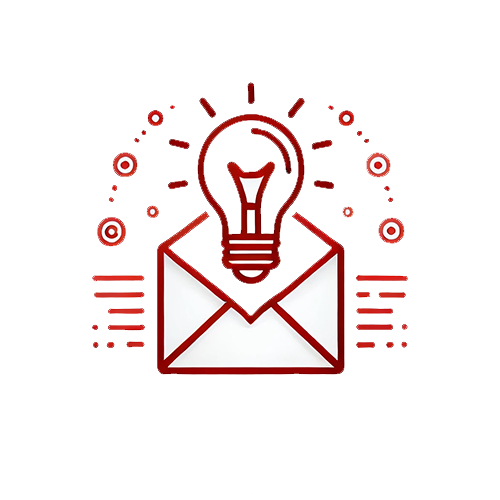
Optional Email Digests
Never miss updates from your favorite channels
- Auto-summarize new videos
- Email delivery option
- Stay updated effortlessly
Email Summaries of Your Favorite Channels
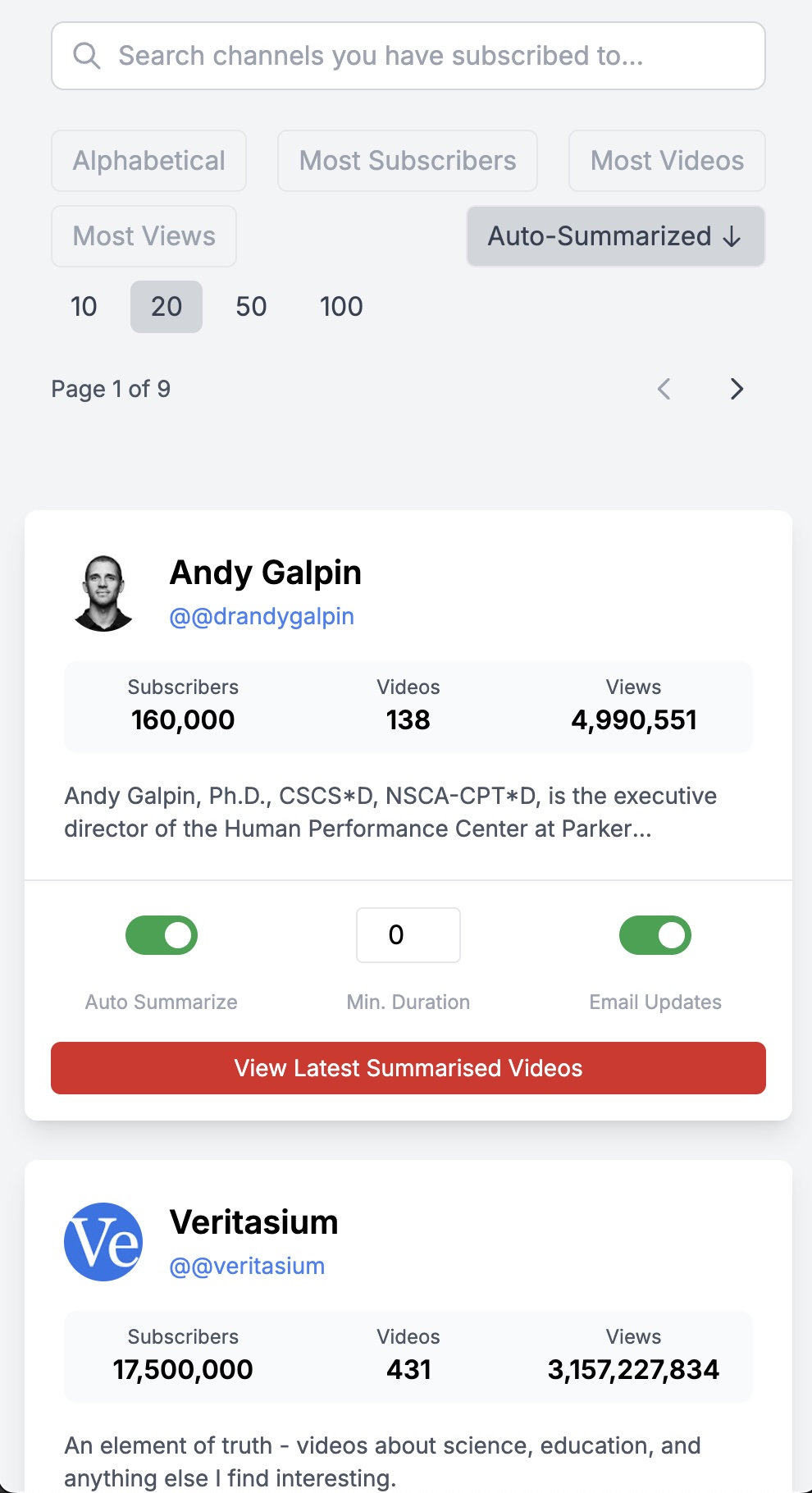
Never miss important content from your favorite channels. Get AI-powered summaries delivered to your inbox whenever new videos drop.
- Auto-summarize new videos from your favorite channels
- Get key insights delivered to your inbox
- Stay updated without watching every video
Instant Summaries While You Watch
Experience YouTube like never before with our Chrome Extension. Get instant AI summaries available right where you watch. Get key insights, topics, and highlights with a single click.
- One-click summaries directly on YouTube videos
- Works with any video length or content type
- Get instant insights without leaving YouTube
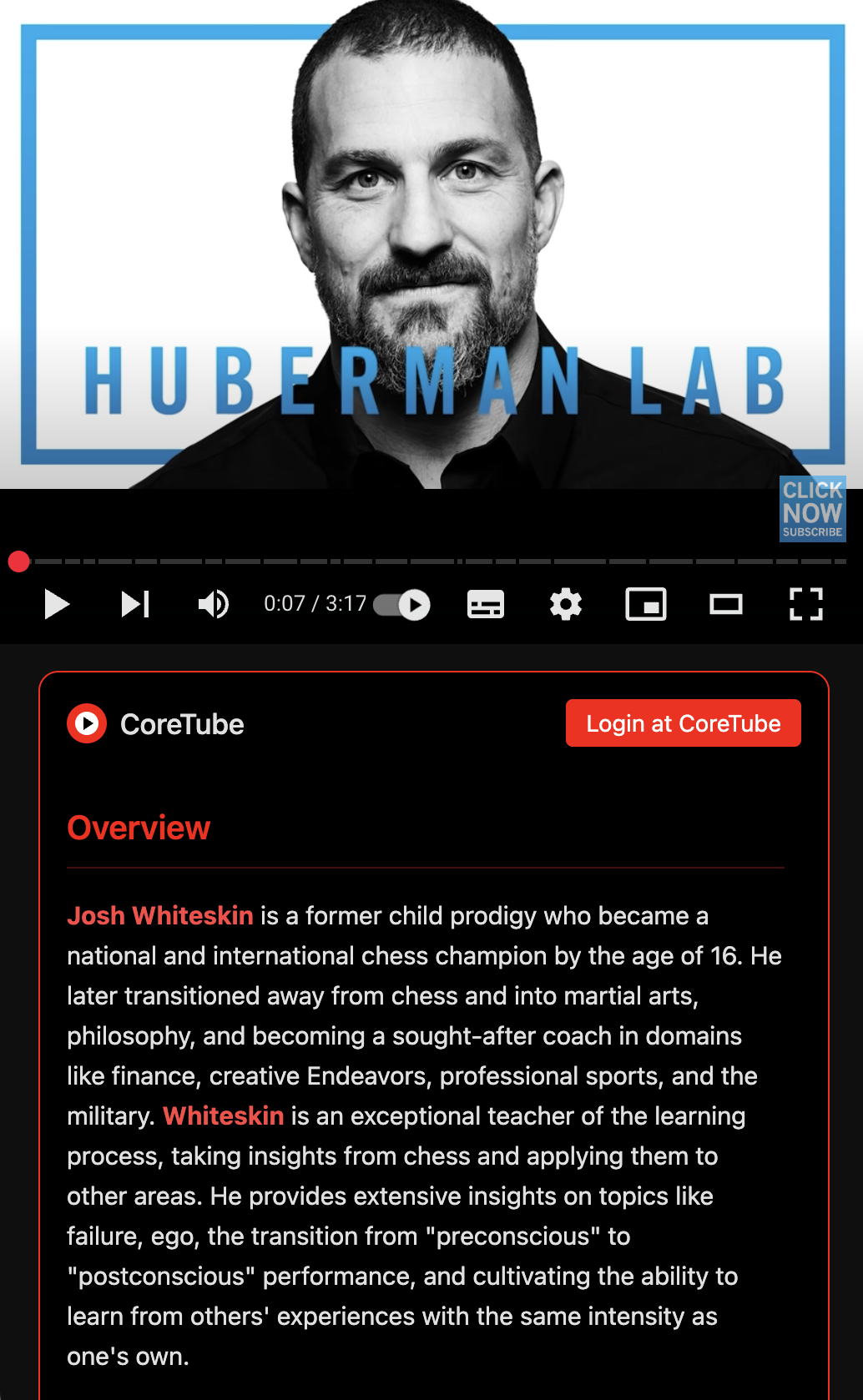
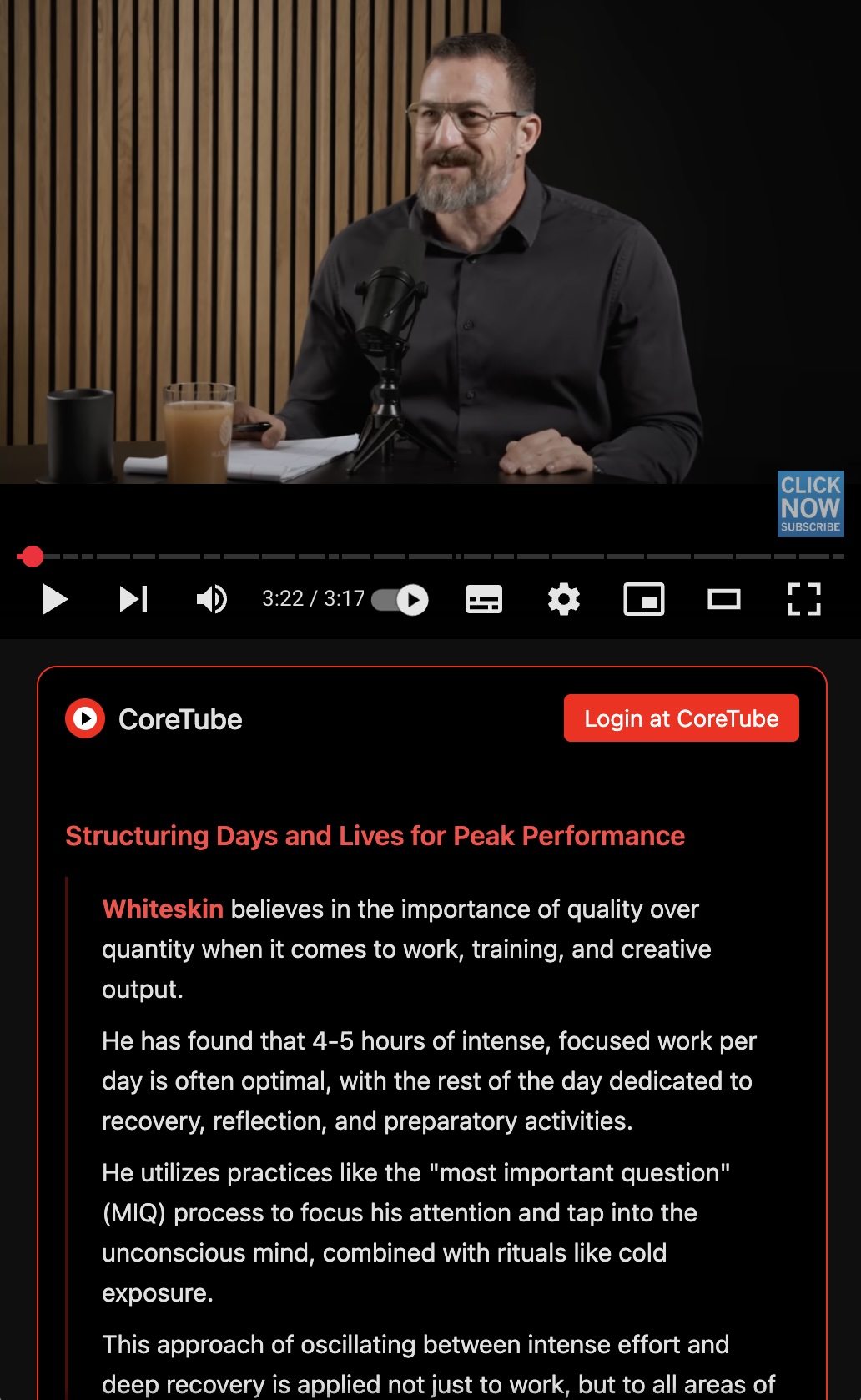
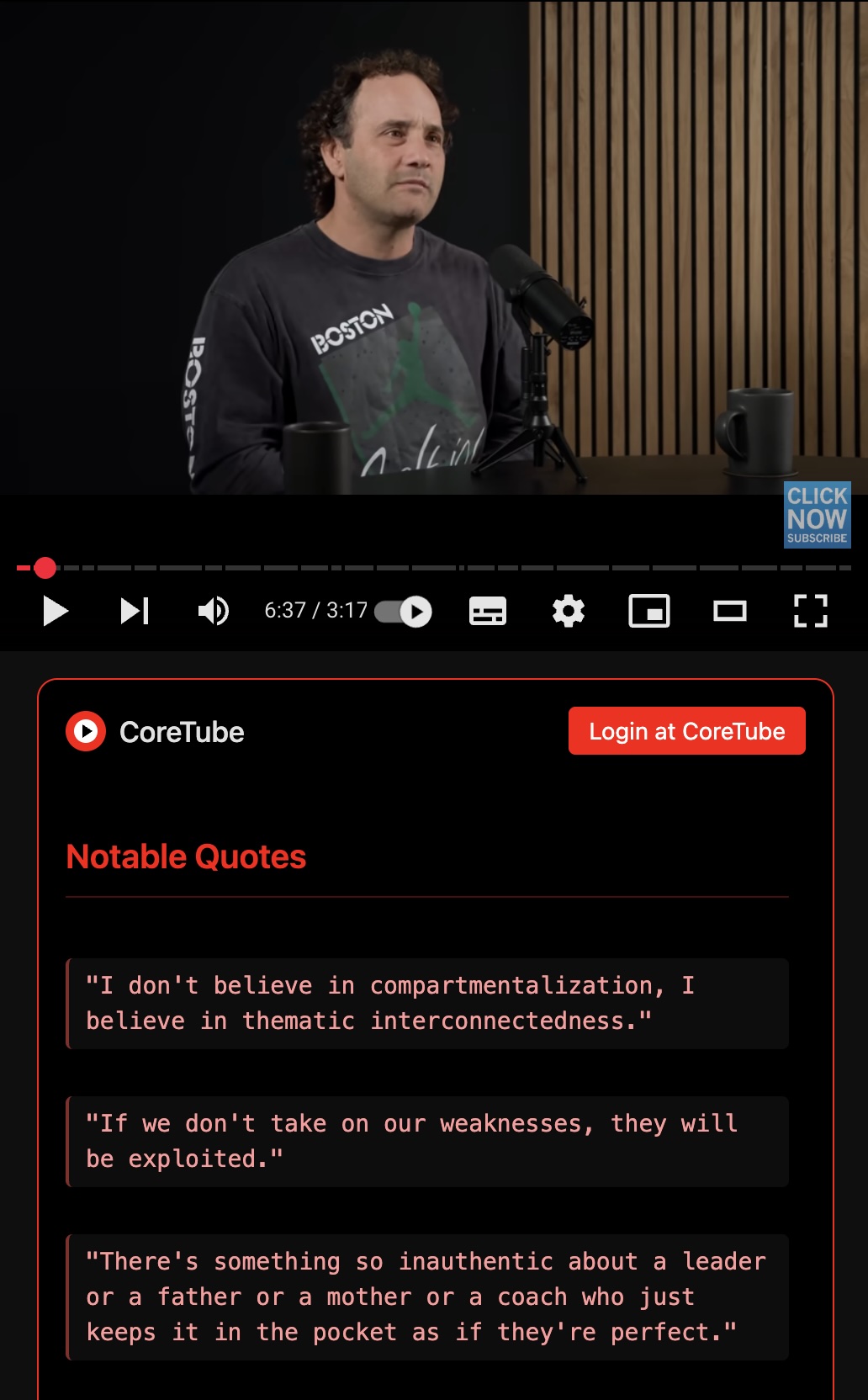
Ready to Transform Your YouTube Experience?
Join thousands who get instant AI summaries while they watch.
Free Chrome extension • Free Account for email digests

